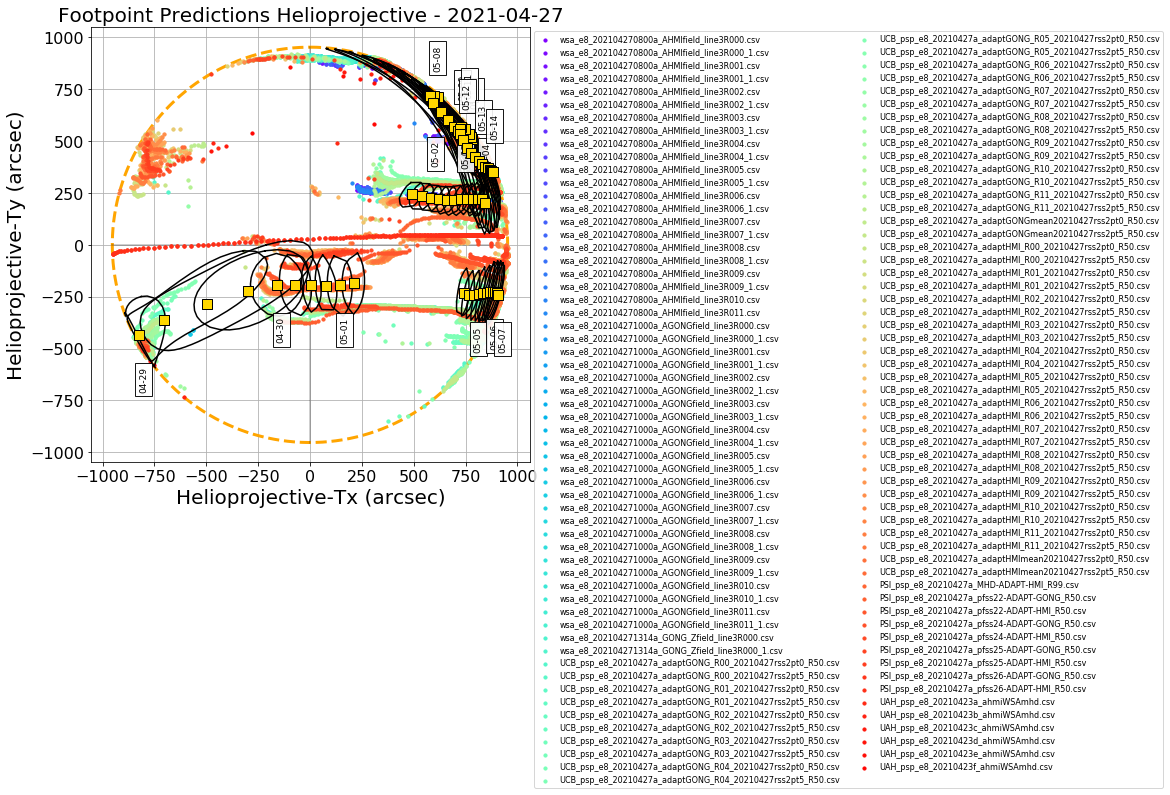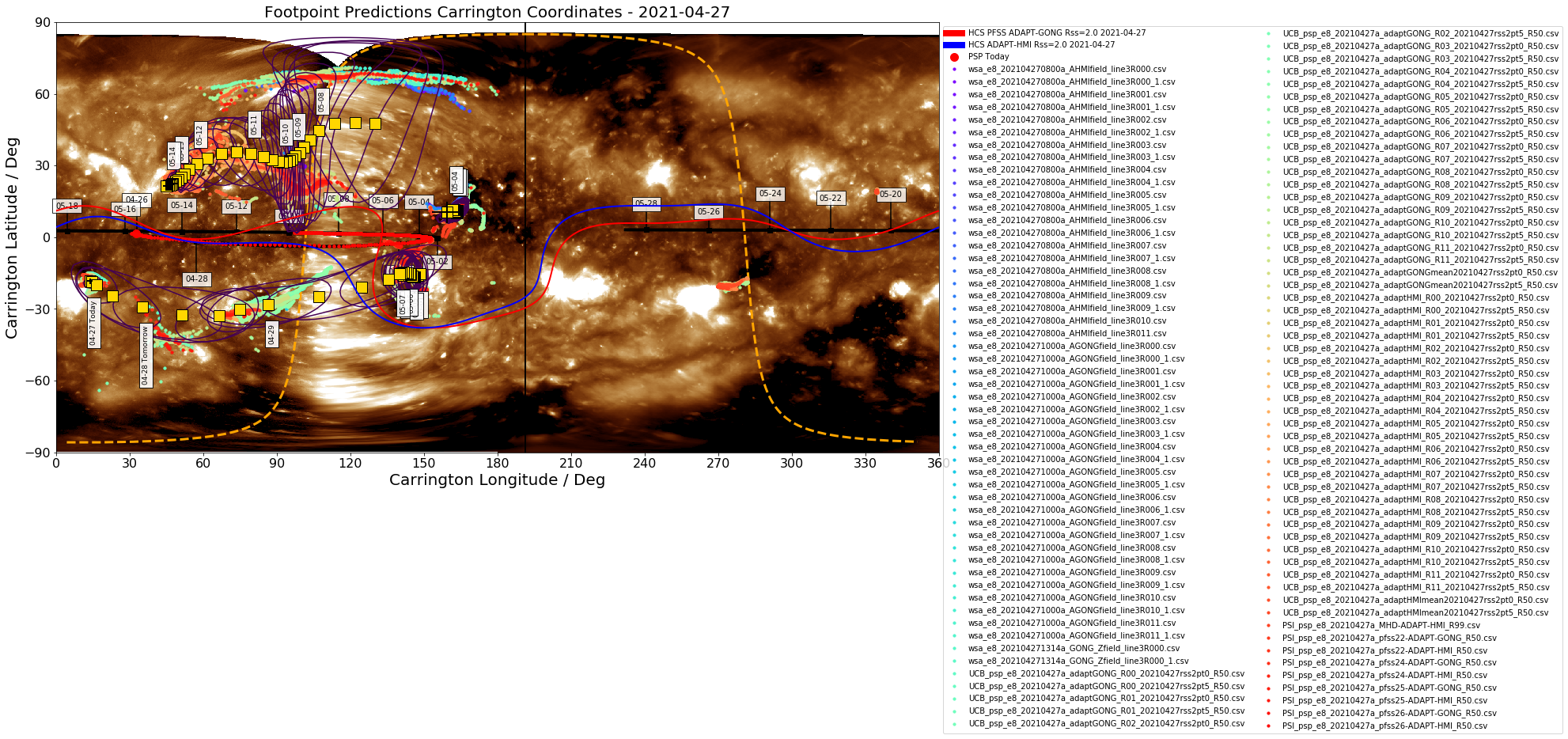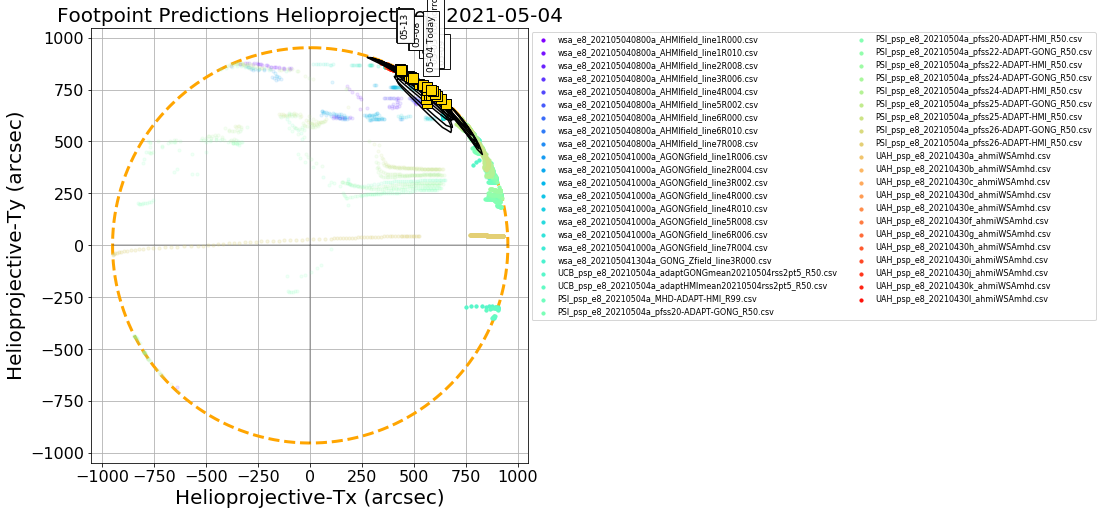
Refer to PSP 7th Perihelion Campaign page.
2021-04-27 (CSV, PDF table of coordinates)

Figure 1.

Figure 2.
Figures above show one footpoint per day plotted on the solar disk and in Carrington coordinates (click on figure to zoom and see caption).
The predicted footpoints were kindly provided by the PSP 8th Perihelion modeling team.
Prediction update 2021/4/27
At the writing of this prediction, PSP is currently connecting behind the East limb to the parts of the Sun with the oldest magnetic field data and it's footpoints are uncertain but most likely connected to the Southern polar coronal hole. Approaching perihelion, PSP's angular velocity is picking up rapidly and around 6pm UT on April 28th we anticipate it will cross the East limb and start to connect to visible features on the solar disk. Due to the high velocity across the disk the configuration will change rapidly and so we present below a breakdown of the encounter into a few segments. Overall, there is a bifurcation between model results. A subset show connections to a series of equatorial coronal holes (seen prominently on April 27th at https://sdo.gsfc.nasa.gov/assets/img/latest/latest_1024_0193.jpg ) while another subset suggests the connection stays with the Northern polar coronal hole boundary. Below we primarily discuss the former case (target [A]), but at all times please be advised the boundary of the northern polar coronal hole remains a possible secondary target too (target [B]).
April 28th 6pm UT - April 29th 6pm UT : PSP emerges at the east limb connecting to the southern polar coronal hole extension and migrates rapidly towards the disk center. The footpoint predictions for this interval place the footpoints at mid-latitudes but this does not appear to correspond to the true boundary of the southern polar coronal hole and is likely limited by the reliance on old photospheric observations. Observers should target the southern polar coronal hole near the East limb.
April 29th 6pm UT - April 30th Midnight : We expect a HCS crossing at this time and a change of connectivity to a small isolated positive polar coronal hole located near the central meridian approximately 380 arcseconds below the equator.
April 30th Midnight UT - May 1st 6am UT : The connectivity to this isolated coronal hole persists and corotates with it as it crosses the central meridian. The secondary target is the Northern polar coronal hole boundary near the central meridian.
Observers should target [A] the isolated coronal hole around 380'' S and [B] the northern polar coronal hole boundary at the central meridian as a secondary target.
May 1st 6am UT - May 4th 6am : As PSP super rotates past the isolated coronal hole, it will (while remaining in positive unipolar solar wind), connect to the eastern boundary of the larger coronal hole around 250 arcseconds above the equator. Over the next few days, with PSP's angular velocity slowing this connection will persist and corotate towards the West limb. The secondary target is the northern polar coronal hole boundary near the West limb. Observers should target [A] the mid-latitude coronal hole at 250''N and [B] the northern polar coronal hole boundary at the West limb.
May 4th 6am - May 7th - To close out the campaign, as PSP approaches outbound corotation, the Sun will again outpace PSP. In the primary prediction, PSP connects again to the isolated coronal hole from April 30th, followed by jumping back to the Northern polar coronal hole after May 7th, but the secondary prediction suggests the connection remains on the northern polar coronal hole near the west limb.An update to this prediction will be posted on Tuesday May 4th. Observers should target [A] the isolated coronal hole at 380''S and [B] the northern polar coronal hole boundary at the West limb.
2021-05-04 (CSV, PDF table of coordinates)

Figure 1.

Figure 2.
Figures above show one footpoint per day plotted on the solar disk and in Carrington coordinates (click on figure to zoom and see caption).
The predicted footpoints were kindly provided by the PSP 8th Perihelion modeling team.
Prediction update 2021/5/4
This update closes out the Encounter 8 prediction period, and projects PSP's connection through May 15th. The consensus prediction for the remainder of the encounter now favours continuous Northern Polar coronal hole (NPCH) connectivity near the West limb.
Over the course of May 4th, PSP will have left the mid-latitude CH that it was primarily connected to last week and will track northwards to the Northern polar coronal boundary. Having gone through corotation and slowed with respect to the Sun, PSP's connection will likely persist on disk at least through May 13th, and the boundary of the NPCH remain the primary target for this time.
A subset of models (specifically PFSS with lower source surface) point to some lower latitude coronal holes that may connect to PSP as they reach the West limb. There is some evidence to support their existence in AIA 193 observations (https://sdo.gsfc.nasa.gov/assets/img/latest/latest_1024_0193.jpg), but overall they are quite tenuous and likely to evolve a lot before they reach the West limb, therefore we advise them as a secondary target if they look prominent as they approach the limb.
In summary, our prediction through May 15th is for [A] NPCH connectivity and then limb passage on May 13th and [B] an advisory to monitor for prominent mid-latitude coronal holes approaching the West limb through this time.
Time, consensus carrington longitude (deg), latitude (deg), error in longitude, error in latitude, helioprojective position in X and Y (arcseconds), and Cons-Type which describes the method used to generate the consensus. The consensus is generated by forming a distribution of footpoint predictions from all modelers for each 24 hour period, and attempting to fit a Kent distribution . If the fitting fails (Cons-Type = median), the median in longitude and latitude are quoted. If the fitting is successful (Cons-Type = Kent), the quoted errors are formed by drawing random samples from the fitted distribution and computing the standard deviation in longitude and latitude of those samples. If the fitting fails, the quoted errors are the standard deviation in the longitude and latitude from the raw distribution of predictions. The full shape of the distribution is described by black contours in the associated plots on this website.
**Please note the carrington coordinates (lon,lat) are valid from the quoted timestamp (in UTC) until the next timestamp. The helioprojective coordinates quoted (HP-Tx, HP-Ty) are computed from the carrington coordinate at the quoted timestamp (e.g. midnight UTC each day) and so are valid instantaneously at this time but will corotate with the Sun until the next quoted timestamp.
Individual model prediction tables of coordinates may be found in a Public DropBox. Files in the Public DropBox have three-letter identifiers indicating the associated model (see below).
Three-letter designation for Public DropBox: UCB. Kindly provided by Sam Badman. The model is a simple ballistic propagation from PSP down to the source surface assuming slow wind 360km/s, and then tracing this sub-PSP trajectory through a PFSS model to get footpoints at the photosphere. The source surface height here is 2.5Rs. The PFSS model is generated using various ADAPT maps with GONG and HMI as input, and the model is run using the open source pfsspy package. A more detailed explanation of the model and comparison to PSP E1 results are given here.
Three-letter designation for Public DropBox: PSI. Kindly provided by Pete Riley. For these predictions, PSI is using a combination of modeling approaches, including PFSS solutions, empirically-based polytropic MHD solutions, and a more sophisticated approach that includes the effects of waves and turbulence to heat the corona and the WKB approximation for wave pressures to accelerate the solar wind. Additionally, boundary conditions are derived from both HMI and ADAPT synoptic magnetograms. Together, these allow us to generate a rich set of ensemble realizations from which to make our optimal prediction, as well as pool them with other teams’ forecasts to derive a hyper-ensemble prediction.
Three-letter designation for Public DropBox: WSA. Kindly provided by Shaela Jones. The Wang-Sheeley-Arge (WSA) model is a combined empirical and physics-based model of the corona and solar wind. The coronal portion of the Wang-Sheeley-Arge (WSA) model is comprised of the Potential Field Source Surface (PFSS) and Schatten Current Sheet (SCS) models, where the output of the PFSS model serves as input to the SCS model. The solar wind portion of WSA consists of a simple 1-D kinematic propagation code that takes stream interactions into account in an ad-hoc fashion. It provides predictions of the solar wind speed and interplanetary magnetic field IMF polarity at any specified point in the inner heliosphere. The WSA model can use global maps of the photospheric magnetic flux measurements from a number of sources as its inner boundary condition; here we are using an ensemble of maps from the Air Force Data Assimilative Photospheric Flux Transport (ADAPT) model, based on input GONG magnetograms.
UAH predictions come from the University of Alabama, Huntsville Multiscale Fluid-Kinetic Simulation Suite (MS-FLUKSS, Pogorelov et al. (2014); Pogorelov (2023); Singh et al. (2022)), which can solve the Reynolds-averaged ideal MHD equations for the mixture of thermal and nonthermal solar wind ions coupled with the kinetic Boltzmann equation describing the transport of neutral atoms. An adaptive mesh refinement technique can be employed for efficient high-resolution calculations. The MS-FLUKSS heliospheric MHD model is coupled with the WSA model (Kim et al., 2020), which uses both ADAPT-GONG and ADAPT-HMI input magnetograms, with the PFSS source surface height and the WSA outer boundary at 2.5 and 10 solar radii, respectively. Hence, field line tracing is performed through the MHD domain down to 10 solar radii instantaneously at approximately 1 hour cadence, where the origin of the field line on the photosphere is already known, as described for WSA.
see Prediction and Verification of Parker Solar Probe Solar Wind Sources at 13.3Rs, Badman et al. (2023)